The Patterns of Dissolved N2O Concentrations Are Driven by Nutrient Stoichiometry Related to Land Use Types in the Yiluo River Basin, China
Abstract
1. Introduction
2. Materials and Methods
2.1. Site Description and Sampling Design
2.2. Sample Collection and Analysis
2.3. Land Use Type Determination
2.4. Statistical Analysis
3. Results
3.1. N2O Concentrations in the YLR Basin
3.2. Changes in Hydrographic Factors and the Effects on N2O Concentrations
3.2.1. Changes in Water Physiochemical Conditions and the Effects on N2O Concentrations
3.2.2. The Effects of Land Cover Types on the Environmental Characteristics of the Tributaries
3.3. Calculated EF5r in the YLR Basin During Different Sampling Seasons
4. Discussion
4.1. The Driving Factors of the N2O Concentrations in the YLR Basin
4.2. The Driving Factors of the EF5r Values in the YLR Basin
5. Conclusions
Supplementary Materials
Author Contributions
Funding
Data Availability Statement
Acknowledgments
Conflicts of Interest
References
- Quoc, B.N.; Cavanaugh, S.K.; Hunt, K.A.; Bryson, S.J.; Winkler, M.K.H. Impact of aerobic granular sludge sizes and dissolved oxygen concentration on greenhouse gas N2O emission. Water Res. 2024, 255, 121479. [Google Scholar] [CrossRef]
- Thompson, R.L.; Lassaletta, L.; Patra, P.K.; Wilson, C.; Wells, K.C.; Gressent, A.; Koffi, E.N.; Chipperfield, M.P.; Winiwarter, W.; Davidson, E.A.; et al. Acceleration of global N2O emissions seen from two decades of atmospheric inversion. Nat. Clim. Change 2019, 9, 993–998. [Google Scholar] [CrossRef]
- Beaulieu, J.J.; Christopher, T.N.; Young, J.L. Controls on nitrous oxide production and consumption in reservoirs of the Ohio River Basin. J. Geophys. Res. Biogeosci. 2015, 120, 1995–2010. [Google Scholar] [CrossRef]
- Turner, P.A.; Griffis, T.J.; Lee, X.; Baker, J.M.; Venterea, R.T.; Wood, J.D. Indirect nitrous oxide emissions from streams within the US Corn Belt scale with stream order. Proc. Natl. Acad. Sci. USA 2015, 112, 9839–9843. [Google Scholar] [CrossRef]
- Campeau, A.; del Giorgio, P.A. Patterns in CH4 and CO2 concentrations across boreal rivers: Major drivers and implications for fluvial greenhouse emissions under climate change scenarios. Glob. Change Biol. 2014, 20, 1075–1088. [Google Scholar] [CrossRef]
- Battin, T.J.; Lauerwald, R.; Bernhardt, E.S.; Bertuzzo, E.; Gener, L.G.; Hall, R.O.; Hotchkiss, E.R.; Maavara, T.; Pavelsky, T.M.; Ran, L.; et al. River ecosystem metabolism and carbon biogeochemistry in a changing world. Nature 2023, 613, 449–459. [Google Scholar] [CrossRef] [PubMed]
- Harrison, J.A.; Matson, P.A.; Fendorf, S.E. Effects of a diel oxygen cycle on nitrogen transformations and greenhouse gas emissions in a eutrophied subtropical stream. Aquat. Sci. 2005, 67, 308–315. [Google Scholar] [CrossRef]
- Wang, J.; Chen, N.; Yan, W.; Wang, B.; Yang, L. Effect of dissolver oxygen and nitrogen on emission of N2O from rivers in china. Atmos. Environ. 2015, 103, 347–356. [Google Scholar] [CrossRef]
- Beaulieua, J.J.; Tank, J.L.; Hamilton, S.K.; Wollheim, W.M.; Hall, R.O., Jr.; Mulholland, P.J.; Peterson, B.J.; Ashkenas, L.R.; Cooper, L.W.; Dahm, C.N.; et al. Nitrous oxide emission from denitrification in stream and river network. Proc. Natl. Acad. Sci. USA 2011, 108, 214–219. [Google Scholar] [CrossRef]
- Anderson, B.; Bartlett, K.; Frolking, S.; Hayhoe, K.; Jenkins, J.; Salas, W. Methane and Nitrous Oxide Emissions from Natural Sources; US EPA, EPA 430-R-10-001; Office of Atmospheric Programs: Washington, DC, USA, 2010.
- Liu, S.; Hu, K.; Xie, Z.; Wang, Y.; You, Y. Redistribution of dissolved inorganic nitrogen loading and transport in global rivers via surface water regulation. Sci. Total Environ. 2025, 963, 178546. [Google Scholar] [CrossRef]
- Baulch, H.M.; Schiff, S.L.; Maranger, R.; Dillon, P.J. Nitrogen enrichment and the emission of nitrous oxide from streams. Glob. Biogeochem. Cycles 2011, 25, GB4013. [Google Scholar] [CrossRef]
- Megonigal, J.P.; Hines, M.E.; Visscher, P.T. Anaerobic metabolism: Linkages totrace gases and aerobic processes. In Treatise on Geochemistry; Elsevier: Amsterdam, The Netherlands, 2004; pp. 273–359. [Google Scholar]
- Sen, I.S.; Boral, S.; Ranjan, S.; Tandon, S.K. Small but important: The role of small floodplain tributaries to river nutrient budgets. ACS Earth Space Chem. 2018, 2, 64–71. [Google Scholar] [CrossRef]
- Chow, M.; Huang, J.C.; Shiah, F.K. Phosphorus dynamics along river continuum during typhoon storm events. Water 2017, 9, 537. [Google Scholar] [CrossRef]
- Mosher, J.J.; Kaplan, L.A.; Podgorski, D.C.; McKenna, A.M.; Marshall, A.G. Longitudinal shifts in dissolved organic matter chemogeography and chemodiversity within headwater streams: A river continuum reprise. Biogeochemistry 2015, 124, 371–385. [Google Scholar] [CrossRef]
- Lemley, D.A.; Taljaard, S.; Adams, J.B.; Strydom, N. Nutrient characterisation of river inflow into the estuaries of the Gouritz Water Management Area, South Africa. Water SA 2014, 40, 687–697. [Google Scholar] [CrossRef]
- Wang, Y.; Wang, Z.-L. Shifts of sediment microbial community structure along a salinized and degraded river continuum. J. Coast. Res. 2018, 342, 443–450. [Google Scholar] [CrossRef]
- Billen, G.; Garnier, J.; Némery, J.; Sebilo, M.; Sferratore, A.; Barles, S.; Benoit, P.; Benoît, M. A long-term view of nutrient transfers through the Seine river continuum. Sci. Total Environ. 2007, 375, 80–97. [Google Scholar] [CrossRef]
- Mwanake, R.M.; Gettel, G.M.; Aho, K.S.; Namwaya, D.W.; Masese, F.O.; Butterbach-Bahl, K.; Raymond, P.A. Land ue, not stream order, controls N2O concentration and Flux in the Upper Mara River Basin, Kenya. J. Geophys. Res.-Biogeosci. 2019, 124, 3491–3506. [Google Scholar] [CrossRef]
- Bussi, G.; Janes, V.; Whitehead, P.G.; Dadson, S.J.; Holman, I.P. Dynamic response of land use and river nutrient concentration to long-term climatic changes. Sci. Total Environ. 2017, 590–591, 818–831. [Google Scholar] [CrossRef]
- Castillo, M.M. Land use and topography as predictors of nutrient levels in a tropical catchment. Limnologica 2010, 40, 322–329. [Google Scholar] [CrossRef][Green Version]
- He, Y.; Wang, X.; Chen, H.; Yuan, X.; Wu, N.; Zhang, Y.; Yue, J.; Zhang, Q.; Diao, Y.; Zhou, L. Effect of watershed urbanization on N2O emissions from the Chongqing metropolitan river network, China. Atmos. Environ. 2017, 171, 70–81. [Google Scholar] [CrossRef]
- Maavara, T.; Lauerwald, R.; Laruelle, G.G.; Akbarzadeh, Z.; Bouskill, N.J.; Van Cappellen, P.; Regnier, P. Nitrous oxide emissions from inland waters: Are IPCC estimates too high? Glob. Change Biol. 2018, 25, 473–488. [Google Scholar] [CrossRef] [PubMed]
- Yao, Y.; Tian, H.; Shi, H.; Pan, S.; Xu, R.; Pan, N.; Canadell, J.G. Increased global nitrous oxide emissions from streams and rivers in the Anthropocene. Nat. Clim. Change 2019, 10, 138–142. [Google Scholar] [CrossRef]
- Davidson, E.A. The contribution of manure and fertilizer nitrogen to atmospheric nitrous oxide since 1860. Nat. Geosci. 2009, 2, 659–662. [Google Scholar] [CrossRef]
- Yu, Z.; Deng, H.; Wang, D.; Ye, M.; Tan, Y.; Li, Y.; Chen, Z.; Xu, S. Nitrous oxide emissions in the Shanghai river network implications for the effects of urban sewage and IPCC methodology. Glob. Change Biol. 2013, 19, 2999–3010. [Google Scholar] [CrossRef]
- Song, K.; Senbati, Y.; Li, L.; Zhao, X.; Xue, Y.; Deng, M. Distinctive microbial processes and controlling factors related to indirect N2O emission from agricultural and urban rivers in Taihu watershed. Environ. Sci. Technol. 2022, 56, 4642–4654. [Google Scholar] [CrossRef]
- Liu, X.; Dai, X.; Zhong, Y.; Li, J.; Wang, P. Analysis of changes in the relationship between precipitation and streamflow in the Yiluo River, China. Theor. Appl. Climatol. 2013, 114, 183–191. [Google Scholar] [CrossRef]
- Upstill-Goddard, R.C.; Salter, M.E.; Mann, P.J.; Barnes, J.; Poulsen, J.; Dinga, B.; Fiske, G.J.; Holmes, R.M. The riverine source of CH4 and N2O from the Republic of Congo, western Congo Basin. Biogeosciemces 2017, 14, 2267–2281. [Google Scholar] [CrossRef]
- Mengis, M.; Gächter, R.; Wehrli, B. Sources and sinks of nitrous oxide (N2O) in deep lakes. Biogeochemistry 1997, 38, 281–301. [Google Scholar] [CrossRef]
- Guo, Y.; Song, C.; Wang, L.; Tan, W.; Wang, X.; Cui, Q.; Wan, Z. Concentrations, sources, and export of dissolved CH4 and CO2 in rivers of the permafrost wetlands, northeast China. Ecol. Eng. 2016, 90, 491–497. [Google Scholar] [CrossRef]
- Wiesenburg, D.A.; Guinasso, N.L. Equilibrium solubilities of methane, carbon monoxide, and hydrogen in water and sea water. J. Chem. Eng. Data 1979, 24, 356–360. [Google Scholar] [CrossRef]
- Weiss, R.F.; Price, B.A. Nitrous oxide solubility in water and seawater. Mar. Chem. 1980, 8, 347–359. [Google Scholar] [CrossRef]
- Hama-Aziz, Z.Q.; Hiscock, K.M.; Cooper, R.J. Indirect nitrous oxide emission factors for agricultural field drains and headwater streams. Environ. Sci. Technol. 2016, 51, 301–307. [Google Scholar] [CrossRef] [PubMed]
- Qin, X.; Li, Y.; Goldberg, S.; Wan, Y.; Fan, M.; Liao, Y.; Wang, B.; Gao, Q.; Li, Y.-E. Assessment of indirect N2O emission factors from agricultural river networks based on long-term study at high temporal resolution. Environ. Sci. Technol. 2019, 53, 10781–10791. [Google Scholar] [CrossRef]
- de Angelis, M.A.; Gordon, L.I. Upwelling and river runoff as sources of dissolved nitrous oxide to the Alsea estuary, Oregon. Estuar. Coast. Shelf Sci. 1985, 20, 375–386. [Google Scholar] [CrossRef]
- Huo, P.; Liu, Y.; Xu, C.; Zhang, X.; Jia, H.; Gao, P. Characteristics of dissolved N2O and indirect N2O emission factor in the groundwater of high nitrate leaching areas in northwest China. Sci. Total Environ. 2023, 868, 161641. [Google Scholar] [CrossRef]
- Hu, M.; Li, B.; Wu, K.; Zhang, Y.; Wu, H.; Zhou, J.; Chen, D. Modeling riverine N2O Sources, fates, and emission factors in a typical river network of eastern China. Environ. Sci. Technol. 2021, 55, 13356–13365. [Google Scholar] [CrossRef]
- Vilain, G.; Garnier, J.; Passy, P.; Silvestre, M.; Billen, G. Budget of N2O emissions at the watershed scale: Role of land cover and topography (the Orgeval basin, France). Biogeosciences 2012, 9, 1085–1097. [Google Scholar] [CrossRef]
- Wilcock, R.J.; Sorrell, B.K. Emissions of greenhouse gases CH4 and N2O from low-gradient streams in agriculturally developed catchments. Water Air Soil Pollut. 2008, 188, 155–170. [Google Scholar] [CrossRef]
- Nguyen, A.T.; Némery, J.; Gratiot, N.; Dao, T.-S.; Le, T.T.M.; Baduel, C.; Garnier, J. Does eutrophication enhance greenhouse gas emissions in urbanized tropical estuaries? Environ. Pollut. 2022, 303, 119105. [Google Scholar] [CrossRef]
- Mao, B.; Wang, X.; Jia, S.; Liu, Z. Multi-methods to investigate the baseflow: Insight from watershed scale spatiotemporal variety perspective. Ecol. Indic. 2024, 158, 111573. [Google Scholar] [CrossRef]
- Shi, G.; Peng, C.; Wang, M.; Shi, S.; Yang, Y.; Chu, J.; Zhang, J.; Lin, G.; Shen, Y.; Zhu, Q. The spatial and temporal distribution of dissolved organic carbon exported from three Chinese rivers to the China Sea. PLoS ONE 2016, 11, e0165039. [Google Scholar] [CrossRef]
- Quick, A.M.; Reeder, W.J.; Farrell, T.B.; Tonina, D.; Feris, K.P.; Benner, S.G. Nitrous oxide from streams and rivers: A review of primary biogeochemical pathways and environmental variables. Earth-Sci. Rev. 2019, 191, 224–262. [Google Scholar] [CrossRef]
- Wang, S.; Li, S.; Ji, M.; Li, J.; Huang, J.; Dang, Z.; Jiang, Z.; Zhang, S.; Zhu, X.; Ji, G. Long-neglected contribution of nitrification to N2O emissions in the Yellow River. Environ. Pollut. 2024, 351, 124099. [Google Scholar] [CrossRef] [PubMed]
- Zhang, M.; Daraz, U.; Sun, Q.; Chen, P.; Wei, X. Denitrifier abundance and community composition linked to denitrification potential in river sediments. Environ. Sci. Pollut. Res. 2021, 28, 51928–51939. [Google Scholar] [CrossRef]
- Zhang, Y.; Song, C.; Zhou, Z.; Cao, X.; Zhou, Y. Coupling between nitrification and denitrification as well as its effect on phosphorus release in sediments of Chinese shallow lakes. Water 2019, 11, 1809. [Google Scholar] [CrossRef]
- Mehnaz, K.R.; Dijkstra, F.A. Denitrification and associated N2O emissions are limited by phosphorus availability in a grassland soil. Geoderma 2016, 284, 34–41. [Google Scholar] [CrossRef]
- O’Neill, R.M.; Duff, A.M.; Brennan, F.P.; Gebremichael, A.W.; Girkin, N.T.; Lanigan, G.J.; Krol, D.J.; Wall, D.P.; Renou-Wilson, F.; Müller, C.; et al. Linking long-term soil phosphorus management to microbial communities involved in nitrogen reactions. Biol. Fertil. Soils 2022, 58, 389–402. [Google Scholar] [CrossRef]
- Borges, A.V.; Darchambeau, F.; Lambert, T.; Bouillon, S.; Morana, C.; Brouyère, S.; Hakoun, V.; Jurado, A.; Tseng, H.C.; Descy, J.P.; et al. Effects of agricultural land use on fluvial carbon dioxide, methane and nitrous oxide concentrations in a large European river, the Meuse (Belgium). Sci. Total Environ. 2018, 610–611, 342–355. [Google Scholar] [CrossRef]
- Patel, L.; Singh, R.; Thottathil, S.D. Land use drivers of riverine methane dynamics in a tropical river basin, India. Water Res. 2023, 228, 119380. [Google Scholar] [CrossRef]
- Que, Z.; Wang, X.; Liu, T.; Wu, S.; He, Y.; Zhou, T.; Yu, L.; Qing, Z.; Chen, H.; Yuan, X. Watershed land use change indirectly dominated the spatial variations of CH4 and N2O emissions from two small suburban rivers. J. Hydrol. 2023, 619, 129357. [Google Scholar] [CrossRef]
- Shao, T.; Wang, T. Effects of land use on the characteristics and composition of fluvial chromophoric dissolved organic matter (CDOM) in the Yiluo River watershed, China. Ecol. Indic. 2020, 114, 106332. [Google Scholar] [CrossRef]
- Wang, X.; Xu, Y.J.; Liu, Z.; Jia, S.; Mao, B. Spatiotemporal changes of nitrate retention at the interface between surface water and groundwater: Insight from watershed scale in an elevated nitrate region. Hydrol. Process. 2023, 37, e14856. [Google Scholar] [CrossRef]
- Fasching, C.; Wilson, H.F.; D’Amario, S.C.; Xenopoulos, M.A. Natural land cover in agricultural catchments alters flood effects on DOM composition and decreases nutrient levels in streams. Ecosystems 2019, 22, 1530–1545. [Google Scholar] [CrossRef]
- Hergoualc’h, K.; Akiyama, H.; Bernoux, M.; Chirinda, N.; del Prado, A.; Kasimir, A.; MacDonald, J.D.; Ogle, S.M.; Regina, K.; van der Weerden, T.J. N2O emissions from managed soils, and CO2 emissions from lime and urea application. In 2019 Refinement to the 2006 IPCC Guidelines for National Greenhouse Gas Inventories; Technical Reports; Intergovernmental Panel on Climate Change (IPCC); IPCC: Geneva, Switzerland, 2019. [Google Scholar]
- Wang, J.; Wang, G.; Zhang, S.; Xin, Y.; Jiang, C.; Liu, S.; He, X.; McDowell, W.H.; Xia, X. Indirect nitrous oxide emission factors of fluvial networks can be predicted by dissolved organic carbon and nitrate from local to global scales. Glob. Change Biol. 2022, 28, 7270–7285. [Google Scholar] [CrossRef] [PubMed]
- Hu, M.; Chen, D.; Dahlgren, R.A. Modeling nitrous oxide emission from rivers: A global assessment. Glob. Change Biol. 2016, 22, 3566–3582. [Google Scholar] [CrossRef]
- Quick, A.M.; Reeder, W.J.; Farrell, T.B.; Tonina, D.; Feris, K.P.; Benner, S.G. Controls on nitrous oxide emissions from the hyporheic zones of streams. Environ. Sci. Technol. 2016, 50, 11491–11500. [Google Scholar] [CrossRef]
- Taylor, P.G.; Townsend, A.R. Stoichiometric control of organic carbon–nitrate relationships from soils to the sea. Nature 2010, 464, 1178–1181. [Google Scholar] [CrossRef]
- Yang, X.; Wang, S.; Zhou, L. Effect of carbon source, C/N ratio, nitrate and dissolved oxygen concentration on nitrite and ammonium production from denitrification process by Pseudomonas stutzeri D6. Bioresour. Technol. 2012, 104, 65–72. [Google Scholar] [CrossRef]
- Yi, N.; Gao, Y.; Zhang, Z.; Wang, Y.; Liu, X.; Zhang, L.; Yan, S. Response of spatial patterns of denitrifying bacteria communities to water properties in the stream inlets at Dianchi Lake, China. Int. J. Genom. 2015, 2015, 572121. [Google Scholar] [CrossRef]
- Zhang, L.; Yao, X.; Tang, C.; Xu, H.; Jiang, X.; Zhang, Y. Influence of long-term inundation and nutrient addition on denitrification in sandy wetland sediments from Poyang Lake, a large shallow subtropical lake in China. Environ. Pollut. 2016, 219, 440–449. [Google Scholar] [CrossRef] [PubMed]
- Zhang, S.B.; Yang, M.J.; Xia, X.H.; Gu, Q.Y.; Gao, Q.; Wang, J.F.; Liu, S.D.; Li, X.K.; Li, Y.J.; Mcdowell, W.H.; et al. Ecological differentiation among nitrous oxide reducers enhances temperature effects on riverine N2O emissions. Glob. Change Biol. 2025, 31, e70096. [Google Scholar] [CrossRef] [PubMed]
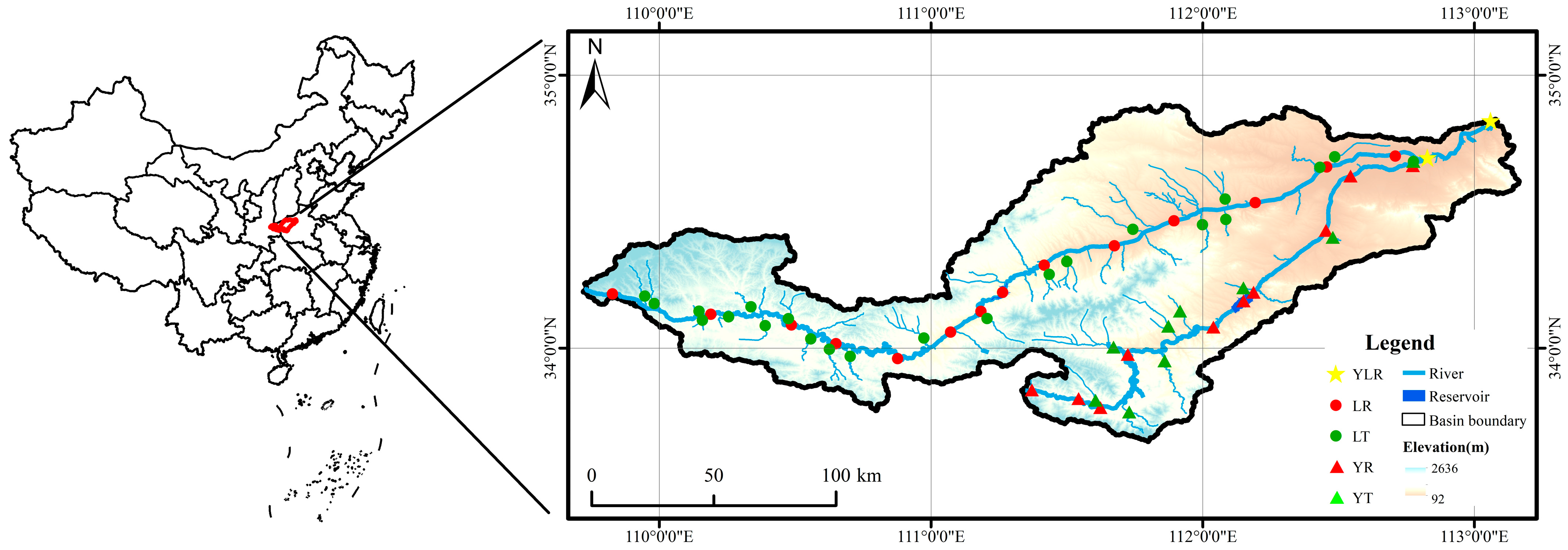
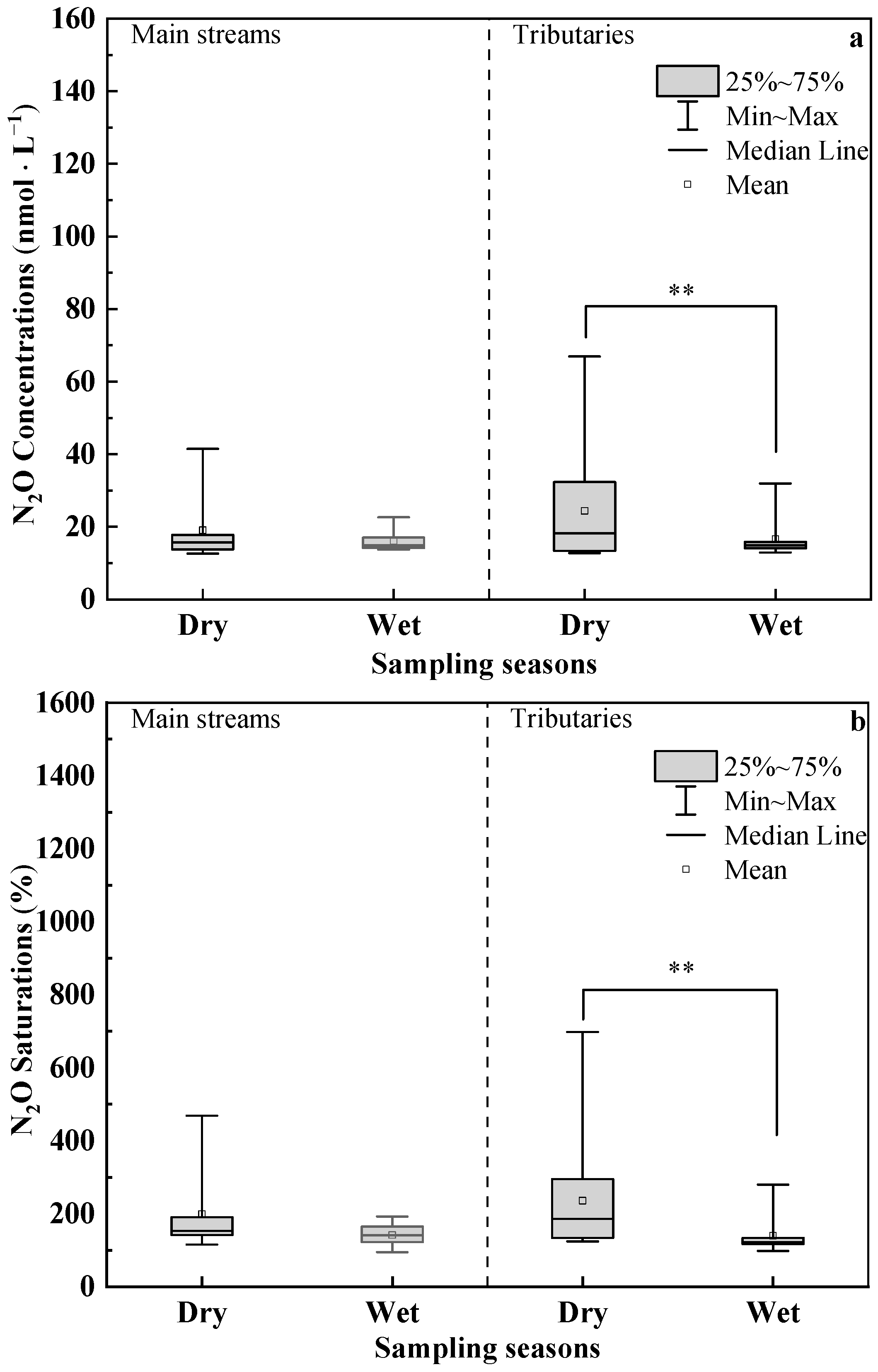
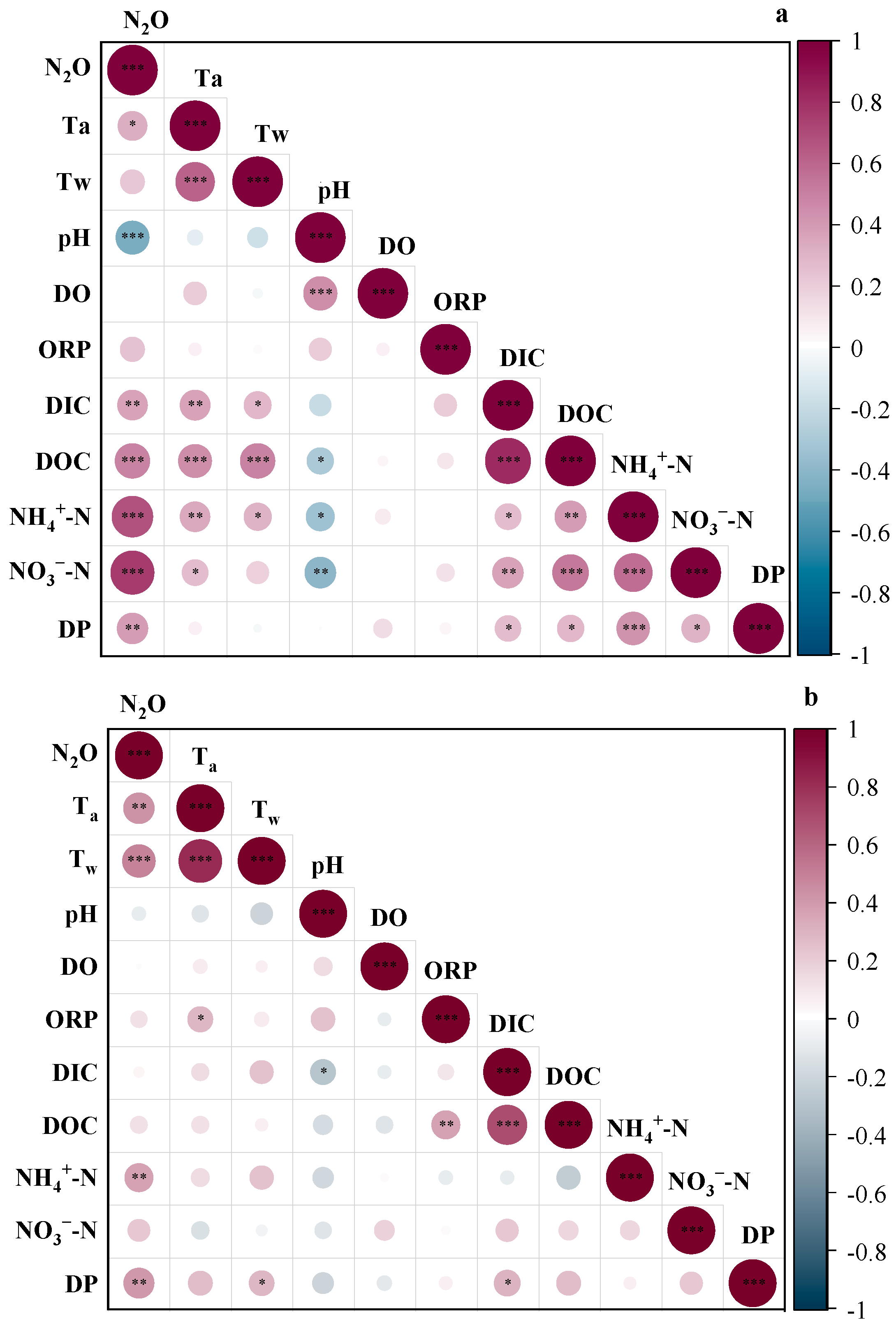
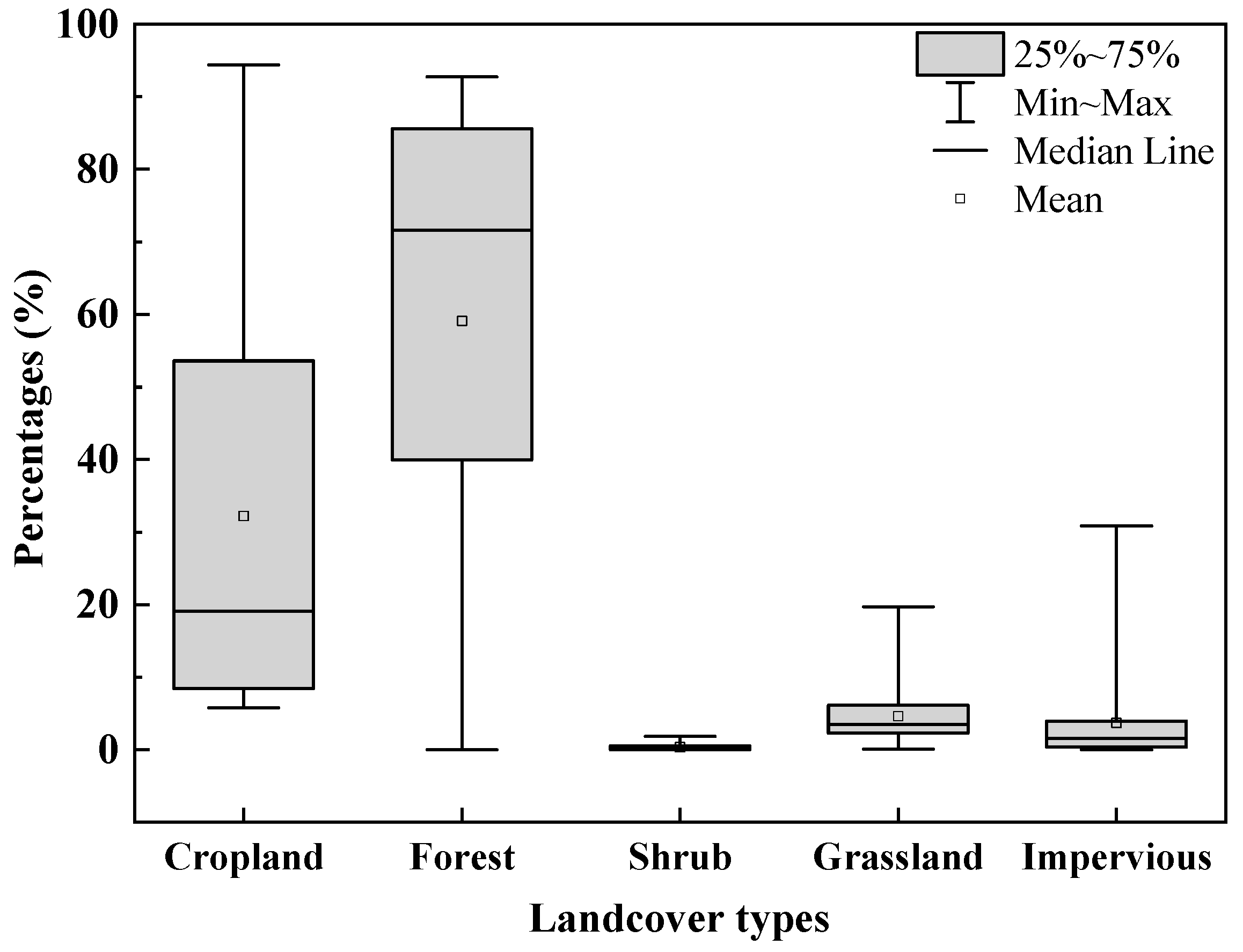
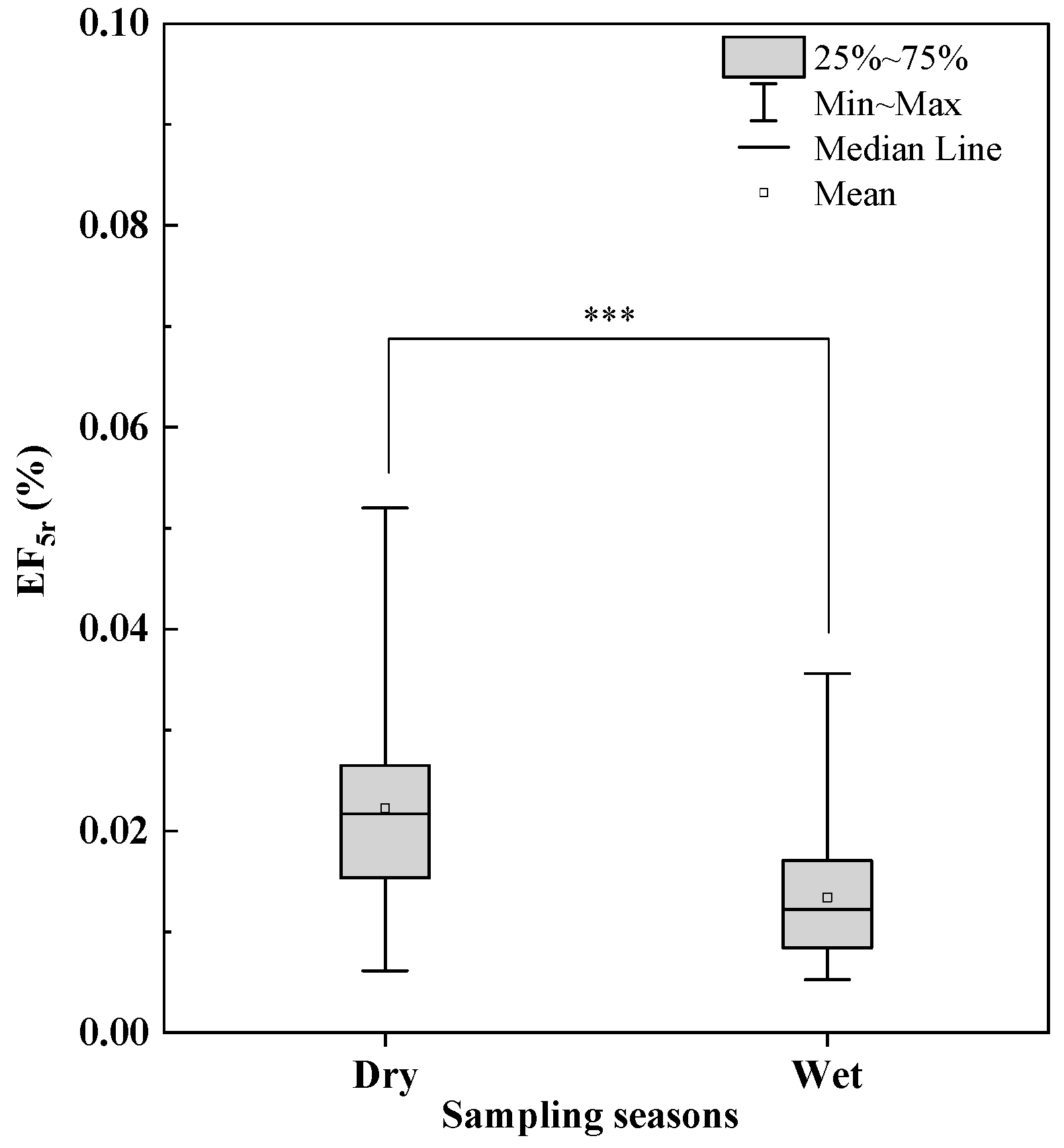
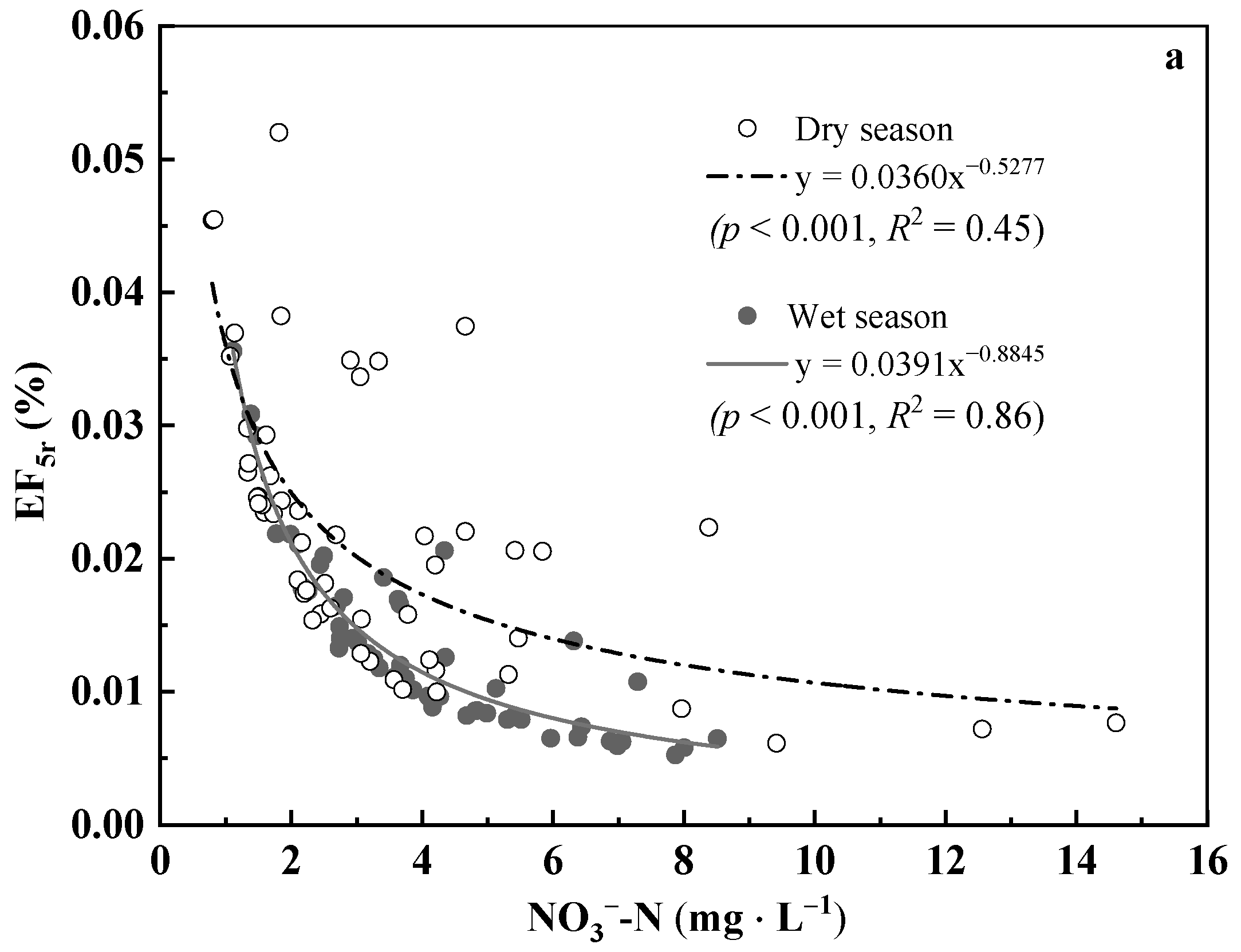
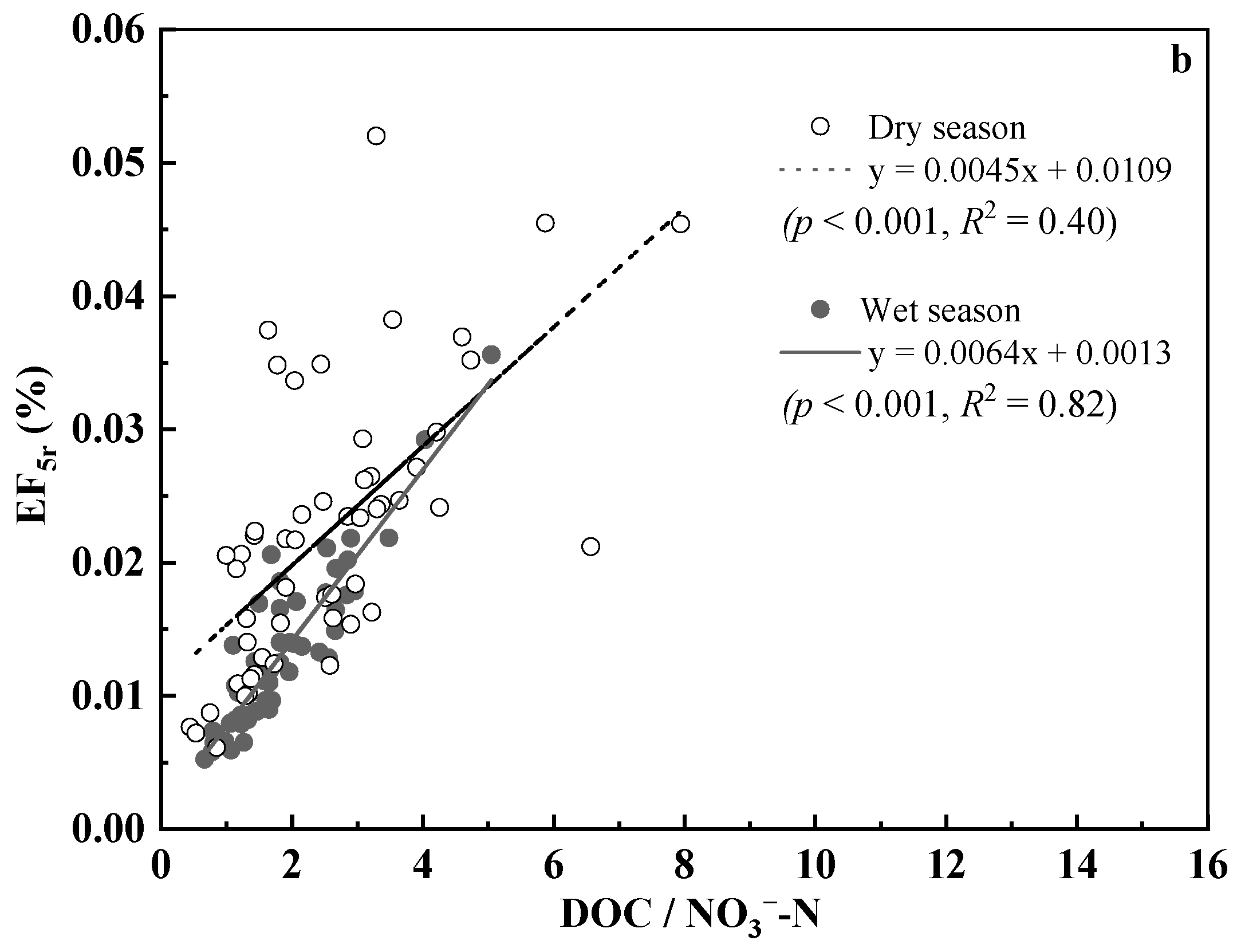
| Sampling Seasons | Ta (°C) | Tw (°C) | pH | DO (mg∙L−1) | ORP | DIC (mg∙L−1) | DOC (mg∙L−1) | NH4+-N (mg∙L−1) | NO3−-N (mg∙L−1) | DP (mg∙L−1) | |
|---|---|---|---|---|---|---|---|---|---|---|---|
| Main streams | Dry | 22.65 (1.06) | 18.79 (0.81) | 7.99 (0.34) | 8.48 (0.11) | 186.17 (4.16) | 10.96 (0.89) | 5.79 (0.21) | 0.58 (0.14) | 2.70 (0.23) | 0.07 (0.01) |
| Wet | 14.63 (0.85) | 14.78 (0.52) | 8.32 (0.18) | 8.47 (0.40) | 137.23 (5.57) | 8.85 (0.40) | 6.20 (0.11) | 0.30 (0.06) | 3.50 (0.23) | 0.04 (0.01) | |
| *** | *** | *** | ** | * | ** | ||||||
| Tributaries | Dry | 21.71 (0.90) | 17.43 (0.58) | 7.92 (0.38) | 8.36 (0.27) | 183.85 (3.69) | 14.08 (1.38) | 6.58 (0.41) | 1.27 (0.46) | 4.15 (0.68) | 0.28 (0.14) |
| Wet | 13.53 (0.68) | 14.65 (0.42) | 8.10 (0.50) | 7.96 (0.54) | 122.11 (14.74) | 10.93 (0.92) | 6.89 (0.41) | 0.30 (0.07) | 4.87 (0.38) | 0.09 (0.04) | |
| *** | *** | ** | *** | ** | * |
| Sampling Season | Step | Factors Entered | F | p | Adjusted R2 |
|---|---|---|---|---|---|
| Dry | 1 | pH | 28.71 | <0.001 | 0.340 |
| 2 | pH, NO3−-N | 23.54 | <0.001 | 0.460 | |
| 3 | pH, NO3−-N, ORP | 18.04 | <0.001 | 0.491 | |
| Wet | 1 | DP | 47.01 | <0.001 | 0.490 |
| 2 | DP, Tw | 30.09 | <0.001 | 0.538 | |
| 3 | DP, Tw, NH4+-N | 26.05 | <0.001 | 0.600 | |
| 4 | DP, Tw, NH4+-N, DOC | 23.26 | <0.001 | 0.640 |
| Land Use | Ta | Tw | pH | DO | ORP | DIC | DOC | NH4+-N | NO3−-N | DP | N2O | |
|---|---|---|---|---|---|---|---|---|---|---|---|---|
| Dry season | Cropland | 0.523 ** | 0.380 * | - | - | - | 0.374 * | 0.467 * | 0.532 ** | - | - | 0.438 * |
| Forest | −0.435 * | - | - | - | - | - | - | −0.409 * | −0.434 * | - | −0.595 ** | |
| Shrub | - | - | 0.652 ** | - | - | - | −0.484 ** | −0.579 ** | −0.676 ** | - | −0.854 ** | |
| Grassland | - | - | 0.420 * | - | - | - | - | - | −0.399 * | - | −0.475 ** | |
| Impervious | 0.411 * | - | - | - | - | 0.554 ** | 0.572 ** | 0.499 ** | 0.550 ** | - | 0.620 ** | |
| Total area | - | 0.379 * | - | - | - | - | - | - | - | - | - | |
| Wet season | Cropland | 0.394 * | 0.534 ** | - | −0.416 * | - | - | - | - | - | - | 0.435 * |
| Forest | - | −0.461 * | 0.473 ** | - | 0.383 * | - | - | - | - | - | −0.508 ** | |
| Shrub | −0.584 ** | −0.557 ** | - | - | - | - | - | −0.385 * | −0.417 * | −0.389 * | −0.526 ** | |
| Grassland | - | - | - | - | - | - | - | - | - | - | - | |
| Impervious | 0.505 ** | 0.707 ** | −0.594 ** | - | - | - | - | 0.373 * | 0.372 * | - | 0.527 ** | |
| Total area | - | - | - | - | - | 0.370 * | 0.414 * | - | - | - | - |
Disclaimer/Publisher’s Note: The statements, opinions and data contained in all publications are solely those of the individual author(s) and contributor(s) and not of MDPI and/or the editor(s). MDPI and/or the editor(s) disclaim responsibility for any injury to people or property resulting from any ideas, methods, instructions or products referred to in the content. |
© 2025 by the authors. Licensee MDPI, Basel, Switzerland. This article is an open access article distributed under the terms and conditions of the Creative Commons Attribution (CC BY) license (https://creativecommons.org/licenses/by/4.0/).
Share and Cite
Zhang, H.; Liu, H.; Jiang, B.; Chi, Y.; Zhu, R.; Jing, Y.; Zhu, H.; Li, Y.; Hou, C.; Li, S.; et al. The Patterns of Dissolved N2O Concentrations Are Driven by Nutrient Stoichiometry Related to Land Use Types in the Yiluo River Basin, China. Water 2025, 17, 1167. https://doi.org/10.3390/w17081167
Zhang H, Liu H, Jiang B, Chi Y, Zhu R, Jing Y, Zhu H, Li Y, Hou C, Li S, et al. The Patterns of Dissolved N2O Concentrations Are Driven by Nutrient Stoichiometry Related to Land Use Types in the Yiluo River Basin, China. Water. 2025; 17(8):1167. https://doi.org/10.3390/w17081167
Chicago/Turabian StyleZhang, Hongli, Heng Liu, Bingbing Jiang, Yunyi Chi, Rongchun Zhu, Yujia Jing, Honglei Zhu, Yingchen Li, Cuicui Hou, Shufen Li, and et al. 2025. "The Patterns of Dissolved N2O Concentrations Are Driven by Nutrient Stoichiometry Related to Land Use Types in the Yiluo River Basin, China" Water 17, no. 8: 1167. https://doi.org/10.3390/w17081167
APA StyleZhang, H., Liu, H., Jiang, B., Chi, Y., Zhu, R., Jing, Y., Zhu, H., Li, Y., Hou, C., Li, S., & Gao, W. (2025). The Patterns of Dissolved N2O Concentrations Are Driven by Nutrient Stoichiometry Related to Land Use Types in the Yiluo River Basin, China. Water, 17(8), 1167. https://doi.org/10.3390/w17081167





